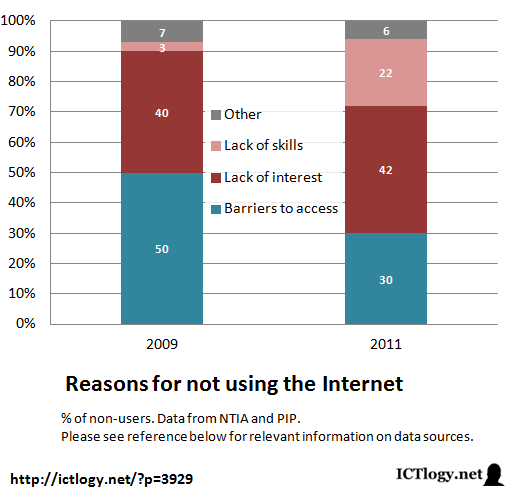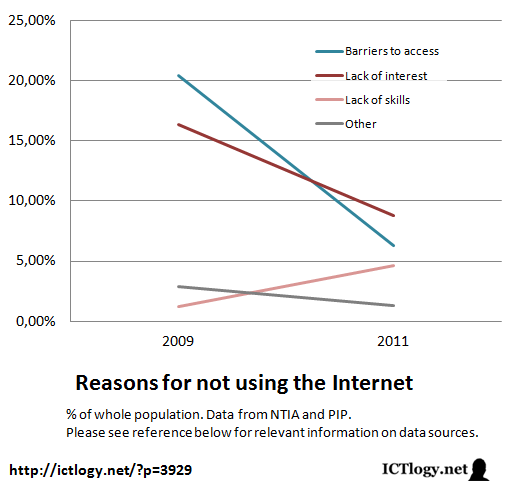In early 2010, the US National Telecommunications and Information Administration issued Digital Nation: 21st Century America’s Progress Towards Universal Broadband Internet Access which, amongst other things, provided data on why people did not use the Internet. Two years later, the Pew Internet & American Life Project provides similar data in Digital Differences. It is very interesting comparing how the reasons for not using the Internet have evolved.
Before entering the analysis, please note that the NTIA actually provided the reasons for not using broadband at home, while PIP measures the reasons for not using the Internet in general. As the difference between broadband and dial-up at that time (October 2009) was circa 5%, and now (August 2011) being 3%, we believe that comparisons, though inaccurate, do indeed provide good enough insights for a quick analysis.
The first chart shows the reasons that non-users state for not using the Internet, measured in percent of non-users. Thus, the chart pictures the share or weight that each reason has in relationship with other reasons for not using the Internet:

Bearing in mind the caveat on the slightly different variables measured by the indicators, we can easily see that the barriers to access (usually lack of infrastructure, affordability and personal disabilities or lack of appropriate/adapted infrastructure) have decreased drastically in less than two years (Oct 2009 to Aug 2011). Yes, there still is an important 30% of non-users that state that the reason for not using the Internet is infrastructures, but the reason has decreased. More competitive markets, the deployment of infrastructures in remote areas and public access points sure are the main causes for this decrease.
On the contrary, lack of skills has sky-rocketed and multiplied its weight by 13%. It is possible that this figure is not actually true, and that the 3% in 2009 is not gathering non-users because of capability reasons (this is most likely — more on that later).
The interesting thing to notice, though, are the steady “Lack of interest” and “Other” reasons, which almost add up to 50% of the people that do not use the Internet. Besides their high share, it is worth stressing their steadiness or even slight increase. There is a constant share of refuseniks that will not use the Internet whatever the government, the market or their peers do to convince them to do otherwise.
The second chart shows again the reasons that non-users state for not using the Internet, but this time measured in percent of the total of the population. Thus, the chart pictures the share or weight that each reason has in relationship with the whole, then giving us an idea of the aggregate number of people that state a specific reason for not using the Internet:

The good thing to note here is that most reasons are decreasing. This is just natural as the overall adoption of the Internet is increasing. So, by construction, one would expect just that.
The not so good thing to note is that the amount of people stating they are not skilled enough to use the Internet does increase. Even if this figure can be (or is) distorted by the different things that data are depicting, it is consistent with other data and observations around, namely (1) the increase of a second-level digital divide caused by different levels of digital skills and (2) the increase of the amount of people that access public access points (telecentres, libraries, cybercafes) not because of the infrastructures — which most have at home — but in seek of advice or help.
Before this scenario, which is not new, a change or shift of public policies to foster the Information Society should take place. Not that policies aimed at more, better and cheaper infrastructures should be abandoned (or yes, that is another debate), but the provision of digital competences to the citizens should be having an increased if not a major role in public policies.
And, of course, it is about much more than putting computers in the classroom.
Bibliography
If you need to cite this article in a formal way (i.e. for bibliographical purposes) I dare suggest:
Peña-López, I. (2012) “The needed shift in policies to foster the Information Society: skills and refuseniks” In ICTlogy,
#103, April 2012. Barcelona: ICTlogy.
Retrieved month dd, yyyy from
https://ictlogy.net/review/?p=3929
Previous post: Conference series on trends in the Information and Knowledge Society
Next post: The conquest of Internet: new maps for new territories
1 Comment to “The needed shift in policies to foster the Information Society: skills and refuseniks” »
 RSS feed for comments on this post.
TrackBack URI
RSS feed for comments on this post.
TrackBack URI


Pingback: ICTlogy » SociedadRed » Comentario al informe La Sociedad de la Información en España 2012 de Fundación Telefónica